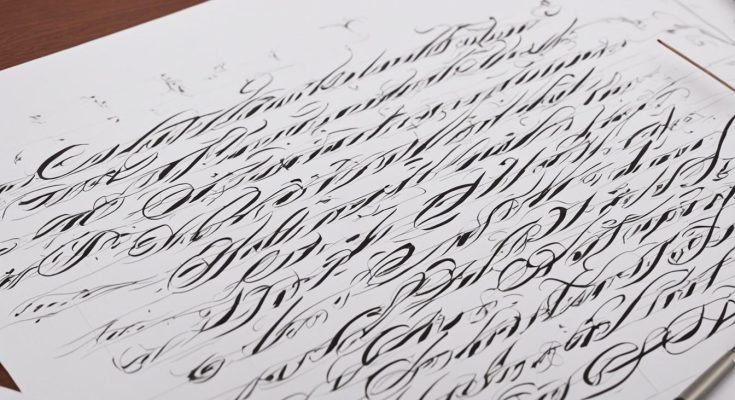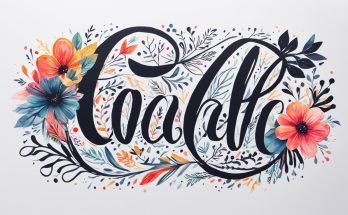Calligraphy Practice for Left-Handers: Discover Tailored Techniques for Perfect Penmanship
Are you a left-hander interested in the art of calligraphy? Don’t worry—calligraphy is not limited to right-handed individuals. With a few adjustments and some tailored techniques, left-handed people can excel in calligraphy and create stunning lettering.
When it comes to holding a brush pen, lefties have three main options: overwriters, horizontal writers, or underwriters. Experiment with different grips to find the most comfortable one that allows for both thick downstrokes and thin upstrokes. It’s all about finding what works best for you!
Smudging can be a common challenge for left-handed calligraphers, but there are ways to minimize it. Try resting your hand on a piece of tracing paper or writing slowly on absorbent paper to reduce smudging. Remember, practice makes perfect, so don’t get discouraged if it takes some time to find the right technique.
Spacing and paper placement are crucial aspects of calligraphy. Lined paper can help maintain consistency and keep your lines straight. You can even rotate the paper to achieve better downstrokes and upstrokes. With a little experimentation, you’ll find the perfect setup that suits your left-handed style.
Choosing the right tools is essential. Left-handed calligraphers can use a variety of pens, including straight or oblique holders, to find what works best for their technique. Explore different options and see which pen feels most comfortable and allows for smooth and controlled strokes.
Finally, remember that practice makes perfect. Regular practice and dedication are key to improving your calligraphy skills. The more you practice, the better you’ll become, regardless of whether you’re left-handed or right-handed. So grab your pen and start exploring the world of calligraphy!
Key Takeaways:
- Left-handed individuals can practice calligraphy with some adjustments and tailored techniques.
- Experiment with different grips to find the most comfortable and effective one for your writing style.
- Minimize smudging by resting your hand on tracing paper or writing slowly on absorbent paper.
- Use lined paper for consistent spacing and proper paper placement.
- Explore different pens, such as straight or oblique holders, to find the one that works best for you.
Left-Handed Calligraphy: Embracing Creativity
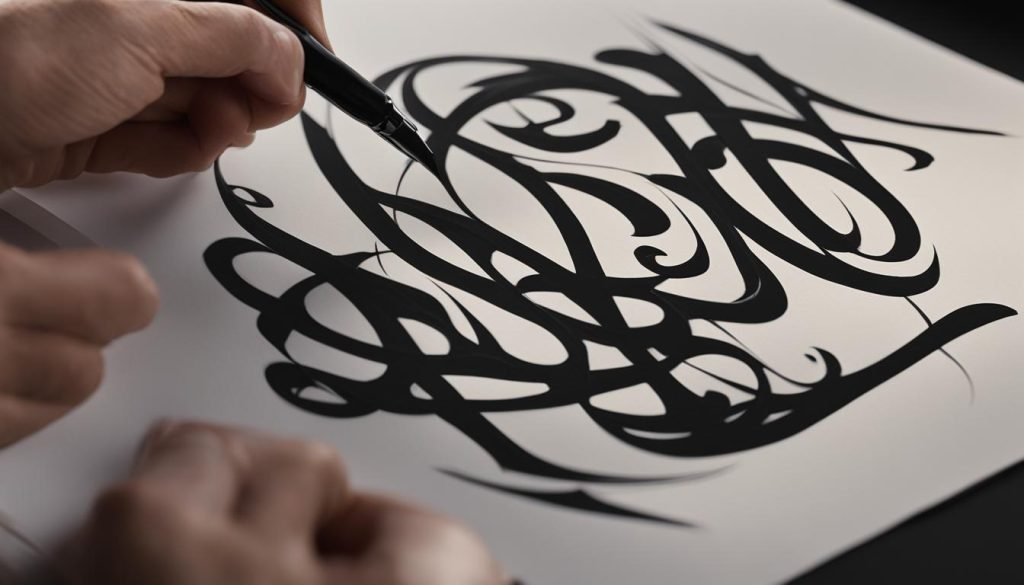
Left-handed calligraphers possess the same level of creativity as their right-handed counterparts. In fact, many famous artists, leaders, and musicians are left-handed individuals who have excelled in their respective fields. Lefties often face the challenge of adapting to a predominantly right-handed world, and the art of calligraphy is no exception.
However, left-handed calligraphers have discovered that by making a few adjustments and finding their own techniques, they can tap into their artistic potential and create stunning works of calligraphic art. With their innovative approaches and unique perspectives, left-handed calligraphers bring a fresh and captivating touch to their creations.
Left-handed calligraphy provides an opportunity for lefties to embrace their creativity and express themselves through the fluidity and beauty of handwritten letterforms. By exploring various styles, experimenting with different lettering techniques, and infusing their personal flair, left-handed artists can produce calligraphy that captivates audiences and carries their own distinct artistic voice.
Overcoming Challenges: Smudging and Smearing
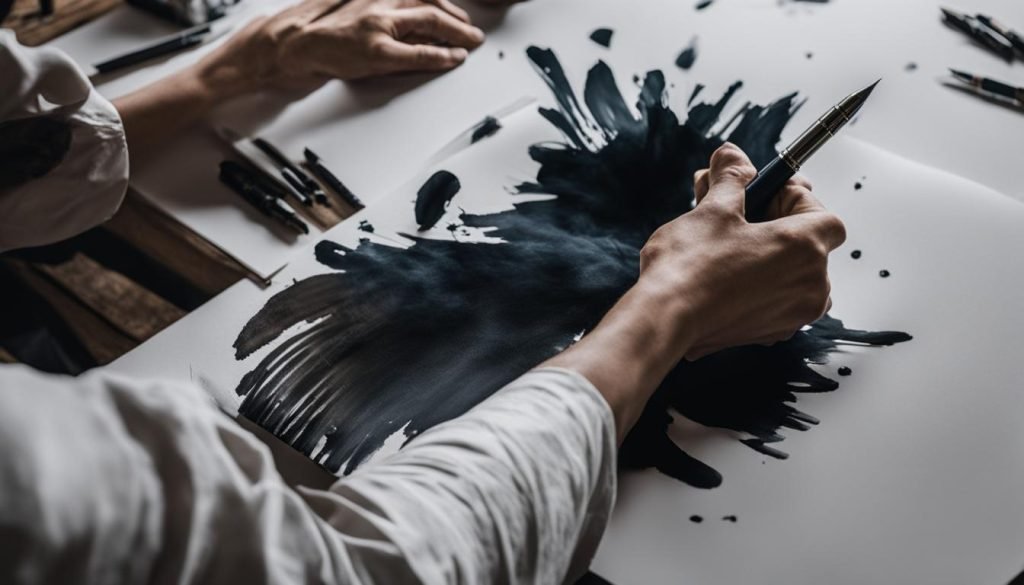
Smudging and smearing are common challenges faced by left-handed calligraphers. When writing from left to right, the hand can unintentionally drag across the freshly written ink, resulting in smudges and smears. However, there are strategies that can help lefties overcome these challenges and achieve better ink control.
To minimize smudging, one effective technique is to rest your hand on a piece of tracing paper as you write. The tracing paper acts as a barrier, preventing direct contact between your hand and the ink. Alternatively, you can try writing slowly and deliberately, giving the ink more time to dry before your hand comes in contact with it.
The choice of paper and brush pen can also play a role in smearing. Different types of papers absorb ink at different speeds. Experiment with various papers to find one that is more ink-resistant and less prone to smudging. Similarly, different brush pens have varying ink flow rates. Opt for pens that provide a controlled amount of ink, reducing the risk of excess ink accumulating and smearing.
Overall, overcoming smudging and smearing requires trial and error. Test different materials, techniques, and ink combinations to find the optimal setup that works for you as a left-handed calligrapher. Don’t be discouraged by initial challenges; with practice and perseverance, you can achieve beautiful, smudge-free calligraphy.
Optimizing Technique: Spacing and Paper Placement
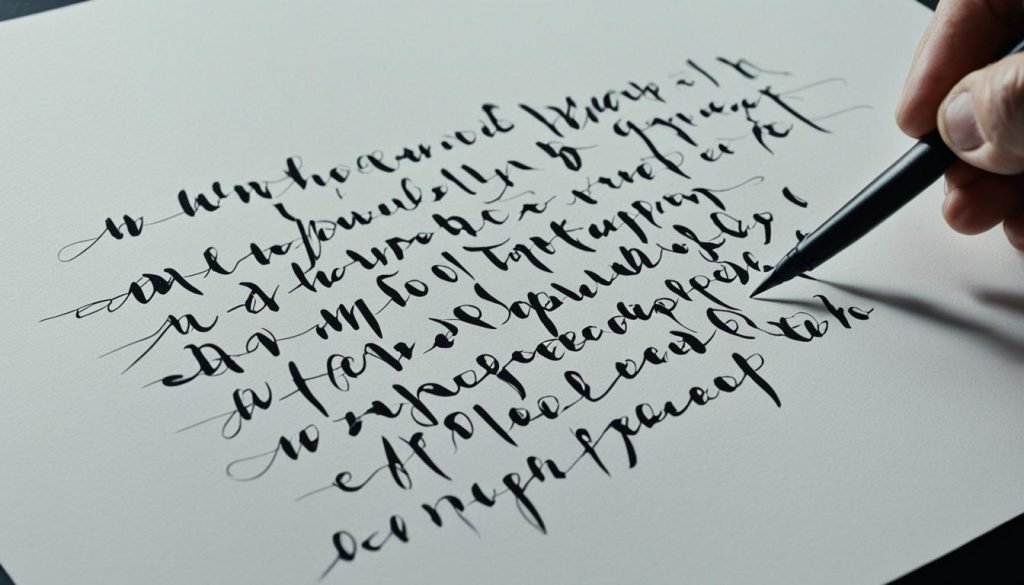
When it comes to calligraphy, left-handed individuals often face challenges with spacing and paper placement. This is especially true for overwriters and horizontal writers whose hands may cover the text they have just written. To overcome these obstacles and achieve beautiful results, there are a few techniques you can employ.
One effective method is to use lined paper beneath your work. The lines act as a guide, helping you maintain consistency and proper spacing between letters and words. By following the lines, you can ensure that your calligraphy maintains a neat and organized appearance.
Another option is to draw light lines directly on the paper. Using a pencil or a light-colored pen, create faint guidelines to follow as you write. These guidelines will serve as a reference for spacing, allowing you to keep your calligraphy uniform and tidy.
If you prefer a more advanced approach, you can invest in a lightbox. A lightbox is a transparent box that illuminates your paper from beneath, making it easier to see the guidelines or templates placed on top. This tool is particularly useful for intricate calligraphy projects that require precise spacing and alignment.
Additionally, paper placement plays a crucial role in left-handed calligraphy. By rotating the paper or adjusting its angle, you can enhance the quality of your downstrokes and upstrokes. Experiment with different orientations to find the most comfortable and efficient position for your hand. This adjustment will help you overcome the unique challenge of writing from left to right.
Try incorporating these techniques into your practice sessions, and you’ll soon notice improvements in your calligraphy skills. With proper spacing and paper placement, your lines will appear straighter and more consistent, resulting in beautifully crafted pieces of art.
Choosing the Right Tools: Pens for Lefties
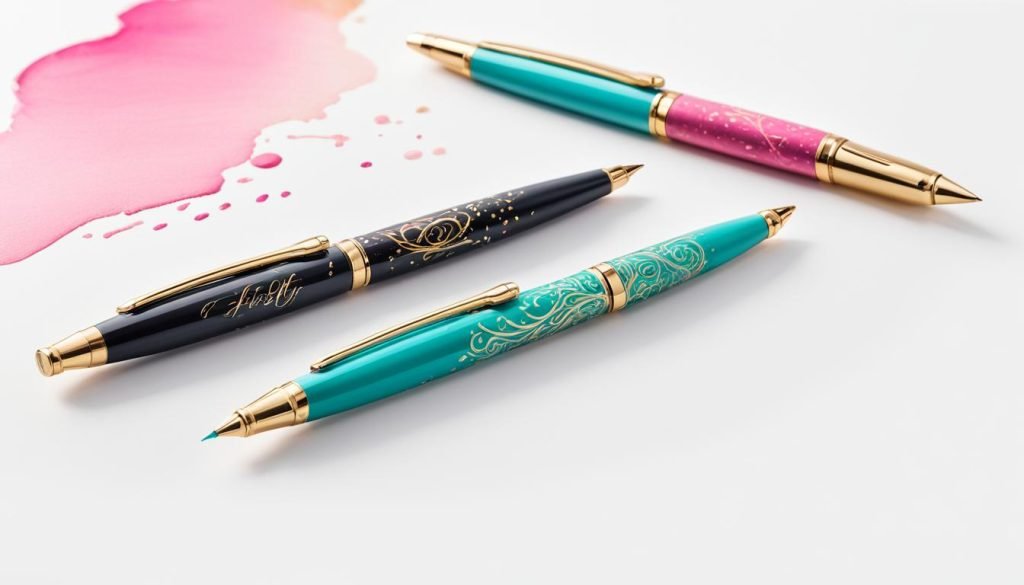
The choice of pens is crucial for left-handed calligraphers. Whether you prefer straight pens, oblique pens, or brush pens, finding the right tools can greatly enhance your calligraphy experience. Let’s explore the options available and their benefits to help you make an informed decision.
1. Straight Pens: These pens are often recommended for left-handed calligraphers due to their simplicity and affordability. They offer a comfortable grip and ease of use, making them ideal for beginners.
2. Oblique Pens: If you’re a lefty who wants to experiment with different nib angles and minimize smudging, oblique pens are worth considering. They allow for better control and can help achieve smoother strokes.
3. Brush Pens: Brush pens are versatile and allow for a wide range of strokes and styles, making them a favorite among calligraphers. Left-handed brush pens are designed to provide a comfortable grip and ensure smooth ink flow, enabling you to create beautiful lettering.
No matter which type of pen you choose, it’s essential to consider personal preference and comfort. The right pen will allow for smooth, controlled strokes and help unleash your creativity.
Tips for Left-Handed Calligraphers:
“Experiment with different pens to find the one that feels most comfortable and suits your technique.”
Remember, calligraphy is a personal art form, and finding the perfect pen for your left-handed technique is an exciting journey. Embrace experimentation, try different pens, and explore the possibilities they offer.
“The right pen can unlock your calligraphy potential and take your skills to new heights.”
Tips from Lefty Calligraphers: Expert Advice
Left-handed calligraphers have invaluable insights and tips to share that can help guide aspiring lefties on their calligraphy journey. By learning from the experiences of these left-handed calligraphy experts, you can enhance your skills and overcome common challenges. Here are some expert tips and techniques to keep in mind:
Finding the Right Grip and Hand Position
One important piece of advice from left-handed calligraphers is to prioritize finding a comfortable grip and hand position. Experiment with different ways of holding your pen or brush to discover what feels most natural and allows for smooth strokes. Remember that everyone’s hand is unique, so find a grip that suits your individual needs.
Exploring Different Angles and Paper Placements
Left-handed calligraphers recommend experimenting with various angles and paper placements to avoid smudging. Tilting the paper slightly or adjusting the pen angle can create a better flow of ink and prevent unwanted smudges. Find the angle and position that works best for you and allows you to maintain control over your strokes.
Patience, Practice, and Perseverance
Improving your calligraphy skills, regardless of your dominant hand, requires patience, practice, and perseverance. Embrace the learning process and understand that mastery takes time. Commit to regular practice sessions and be patient with yourself as you develop your technique and style.
Learning from Fellow Left-Handed Calligraphers
One of the best ways to improve your left-handed calligraphy is to learn from others who share the same challenges. Engage with the calligraphy community, seek out left-handed calligraphers, and join online forums or workshops where you can learn from their experiences and apply their techniques. Collaboration and knowledge sharing can accelerate your progress and inspire new ideas.
“As a left-handed calligrapher, I’ve found that learning from others who face similar challenges has been incredibly beneficial. Don’t be afraid to reach out and connect with fellow lefties – we’re a supportive community!” – Emily Thompson, Left-Handed Calligraphy Expert
By embracing the insights and tips from experienced lefty calligraphers, you can navigate the intricacies of left-handed calligraphy more effectively. Remember to find your preferred grip, experiment with angles and paper placements, practice consistently, and seek inspiration from fellow left-handed calligraphers. With dedication and perseverance, you’ll continue to improve your left-handed calligraphy techniques and create stunning works of art.
| Expert Tip | Description |
|---|---|
| Find a Comfortable Grip | Experiment with different pen or brush grips to find one that feels natural and allows for controlled strokes. |
| Adjust Paper Placement | Tilt the paper or adjust the angle to minimize smudging and achieve better ink flow. |
| Practice Patience | Understand that mastering calligraphy takes time, and progress comes with consistent practice and patience. |
| Learn from Others | Seek advice and techniques from fellow left-handed calligraphers to gain new insights and inspiration. |
Conclusion
Left-handed calligraphy is not only possible but can also yield stunning results. By mastering the right techniques, utilizing the appropriate tools, and dedicating time to regular practice, left-handed calligraphers can overcome common challenges like smudging and spacing and create beautiful lettering. It’s important for left-handed individuals to embrace their creativity and learn from experienced lefty calligraphers to excel in the art of calligraphy.
Don’t let being left-handed hold you back from pursuing calligraphy. With determination and a willingness to explore different approaches, you can unleash your artistic potential and create breathtaking calligraphic pieces. Remember to find a comfortable grip, experiment with paper placement and angles, and choose pens that suit your personal style. The key is to practice consistently and not get discouraged by initial difficulties.
So, if you’re a left-handed individual with a passion for calligraphy, don’t hesitate to pick up a pen and start your calligraphic journey. With patience, perseverance, and a love for the craft, you can master left-handed calligraphy and leave a lasting impression with your beautiful creations.
FAQ
Can left-handed people do calligraphy?
Yes, left-handed people can do calligraphy with a few adjustments.
How should left-handed calligraphers hold their brush pens?
Lefties can hold their brush pens as overwriters, horizontal writers, or underwriters.
How can I minimize smudging as a left-handed calligrapher?
Resting your hand on a piece of tracing paper or writing slowly can help minimize smudging. Experimenting with different papers and brush pens can also help.
How can I maintain spacing and consistency in my calligraphy as a left-handed writer?
You can use lined paper beneath your work, draw light lines directly on the paper, or use a lightbox to maintain spacing and keep lines straight.
What pens should left-handed calligraphers use?
Left-handed calligraphers can use straight pens, oblique pens, or brush pens, depending on their personal preference and comfort.
Do you have any tips from experienced left-handed calligraphers?
Yes, experienced left-handed calligraphers recommend finding a comfortable grip, experimenting with angles, and practicing patience and perseverance.
Can left-handed calligraphers achieve stunning results?
Yes, left-handed calligraphers can achieve stunning results with the right techniques, tools, and practice.

